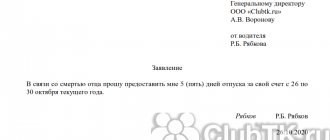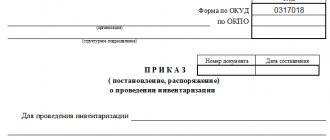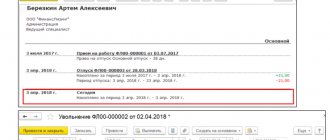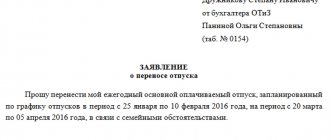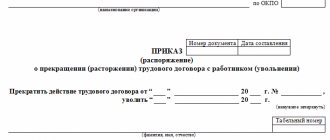At the initiative of the employee
The initiative to take leave without pay comes only from the employee. The employer does not have the right to force such rest on an employee.
There are cases when a manager issues a sample order for leave without pay unconditionally:
| Category | Duration in calendar days |
| Participant of the Great Patriotic War | Up to 35 |
| Working pensioner (old age) | Up to 14 |
| Parent and wife (husband) of military personnel, law enforcement officers who died or died due to injury while performing their duties | Up to 14 |
| Disabled worker | Up to 60 |
| Any employee who has had a child, registered a marriage, or whose relatives have died | Up to 5 |
In other cases, the employer is not obliged to approve the employee’s request.
Conditions for granting leave without pay
An order to allocate time off without pay to an employee is issued and becomes a guide to action subject to the mandatory compliance with the following conditions stipulated by Article 128 of the Labor Code of the Russian Federation (LC):
- The employee voluntarily requested leave without pay.
- An employee who expressed a desire to take a vacation at his own expense drew up and submitted to the head of the company (employer) a written application with a corresponding request - a sample application for vacation at his own expense.
- The applicant motivated the request for unpaid leave with valid reasons (for example, family circumstances) - valid reasons for taking time off without pay.
- If a citizen who has asked for unpaid leave at his own expense belongs to one of the preferential categories outlined in Article 128 of the Labor Code of the Russian Federation, the employer does not have the right to refuse such an applicant. In such cases, time off without pay is necessarily provided to the beneficiary for the period provided for by the relevant provisions of Article 128 of the Labor Code of the Russian Federation. For example, a working age pensioner has the right to rest no more than 14 days per year without receiving a salary - providing leave without pay to a pensioner (disabled employee - maximum 60 days).
- The duration of unpaid leave without pay is agreed upon by the parties (employer and employee). The beneficiaries mentioned above may request a leave of longer duration than that provided for them by Article 128 of the Labor Code of the Russian Federation.
An important condition for applying for leave without pay is the free will of the employee himself, expressed in a corresponding written statement.
This clause applies regardless of who exactly is the real initiator of such rest - the employee or his employer.
If the applicant for unpaid leave is not a beneficiary (according to Article 128 of the Labor Code of the Russian Federation), the director of the company has the right to both approve this request and lawfully reject it.
An employer has no right to force an employee to take time off without pay - details here.
Sample application
The employee addresses the head of the organization with a statement in which he sets out the reasons for his absence and the number of days needed.
There is no set application form. In the upper right corner, the employee indicates his full name. and the position of the manager, the name of the organization. Here he indicates personal data, including position.
The text requires justification of the circumstances that gave rise to the appeal. At the end of the document, you must indicate the date of preparation and sign it.
The application may be written by hand or printed.
We arrange leave without pay
Read in the article:
- What is the procedure for applying for leave without pay?
- What main points should an employer pay attention to when preparing documents?
The procedure for registering leave without pay (at your own expense) actually consists of two main stages: registering the employee’s application and issuing an order .
Stage 1. The written form of the application is mandatory (Part 1 of Article 128 of the Labor Code of the Russian Federation) (example 1). Employers may not take oral requests into account. The employee needs to make sure that the employer receives the application in a timely manner (before he or she is absent from work).
Failure by the employer to receive an application for leave at his own expense (even for employees for whom its provision is mandatory) may lead to the dismissal of the employee as absent for an unexcused reason (Appeal ruling of the Omsk Regional Court dated December 25, 2013 in case No. 33-8376/2013) . Before registering the application, the employer needs to check whether the reason for the leave and its duration are indicated.
SCIENTIFIC EDITOR'S NOTE
An employee who wishes to receive leave without pay for any family circumstances or other reasons important to him is not required to indicate these circumstances/reasons in the application if he does not want them to become known to a large number of people - it is quite enough if he informs about them to the manager orally. The legislator does not establish either a minimum or maximum period of leave without pay for family reasons or other valid reasons. The period is determined by mutual agreement between the employee and the employer (Part 1 of Article 128 of the Labor Code of the Russian Federation).
If the employer sees no obstacles to using vacation at his own expense, an order is issued.
Stage 2. As a rule, an order for granting leave without pay is drawn up according to the unified form No. T-6, approved by Resolution of the State Statistics Committee of the Russian Federation dated January 5, 2004 No. 1 “On approval of unified forms of primary accounting documentation for recording labor and its payment” (example 2), but the employer has the right to develop his own form. The employee should be familiarized with the order upon signature.
Until the head of the organization makes a positive decision to grant the employee leave, the latter cannot take it[1]. According to paragraph 39 of the Resolution of the Plenum of the Supreme Court of the Russian Federation dated March 17, 2004 No. 2 “On the application by the courts of the Russian Federation of the Labor Code of the Russian Federation” (as amended on September 28, 2010), an employment contract with an employee can be terminated under clause. “a” clause 6, part 1, art. 81 of the Labor Code of the Russian Federation for absenteeism, including for unauthorized going on vacation.
ARBITRAGE PRACTICE
The employee believed that she was on leave without pay by agreement with the employer: she submitted the appropriate application, the employer issued an approving visa. However, no order to grant leave was issued. The employer took disciplinary action against the employee for being absent from work. The court agreed with the employer’s arguments, pointing out that since the order to grant the plaintiff leave without pay was not issued, and the employee was absent from work without good reason, the employer had the right to bring her to disciplinary liability.
Appeal ruling of the Tambov Regional Court
dated September 23, 2013 in case No. 33-2717
After issuing an order to grant an employee leave without pay, a note about the leave should be made in Section VIII “Vacation” of the employee’s personal card - using the unified form No. T-2 or the form developed by the organization (example 3). There is no need to familiarize the employee with the entry in the personal card.
FOR YOUR INFORMATION
Since unpaid leave is not paid, there is no need to draw up a calculation note (unified form No. T-60) - it is used only for calculating wages due to the employee and other payments when granting him annual paid or other leave (Instructions for use and filling out forms of primary accounting documentation for recording labor and its payment, approved by Resolution of the State Statistics Committee of Russia dated January 5, 2004 No. 1).
In connection with the provision of leave, it is also necessary to fill out a time sheet (unified forms No. T-12 or No. T-13) (example 4). The conventions for leave at your own expense are as follows:
- • if the leave is granted with the permission of the employer - “UP TO” or “16”;
- • if the employer is obliged to provide it - “OZ” or “17”.
conclusions
- The procedure for applying for leave at your own expense actually consists of two main stages: registering the employee’s application and issuing an order.
- A written application form is required.
- You should make a note about the vacation in Section VIII “Vacation” of the employee’s personal card and fill out a time sheet.
[1] Unless he refers to persons to whom the employer is obliged to provide such leave.
Unified order forms
Resolution of the State Statistics Committee of the Russian Federation dated January 5, 2004 No. 1 established a unified form for leave without pay T-6. But this document is not mandatory for use, so any form of it is legal.
Organizations prefer to use a ready-made form that has lines for entering information.
What must be indicated in the order
When you fill out an order for leave without pay (sample 2022), pay attention to the following columns:
- name and eight-digit code of the organization according to OKPO;
- order number and registration date (precisely registration, although it is written to be filled out, since you can fill it out today and approve it tomorrow);
- FULL NAME. employee;
- the period of his work for which days of rest are provided;
- type of vacation and number of calendar days;
- signature column when reading the order.
The main blocks that must be filled out and require special attention are marked with the letters A (annual basic paid), B (other types of vacation) and C (total number of calendar days).
Block A. Annual basic paid rest
Here we record the periods of rest provided annually to all employees of the organization, without exception.
Sample of filling out an order form for annual leave
Block B. Other types of recreation
These include annual additional paid leave (including educational leave), days off without pay, the period of pregnancy and childbirth (maternity leave), and child care.
Sample order for leave at your own expense
Sometimes it is also called an order for administrative leave without pay.
Block B. Total number of calendar days
The law does not prohibit combining paid and unpaid absence; paid days of rest can smoothly turn into unpaid ones, especially since the T-6 form allows you to express this idea on paper.
Sample of filling out an order form for administrative leave
Sample form of an order for vacation in 2022 using the unified form T-6
The unified HR registration form No. T-6 is a standard form that contains the appropriate fields to fill out.
Differences and accompanying documents
Labor legislation establishes different types of leave, for example, educational, paid and others. The order in which they are provided differs. At the same time, the form that is used is the same for all types - form T-6.
The differences in registration lie in the reflection of information in sections A and B, where there are lines for the annual basic, which is paid, and additional.
The rest order is accompanied by a number of documents:
- schedule in which vacation periods are approved;
- employee appeal;
- a calculation note containing information about the average salary amounts.
Recommendations for placing an order for leave without pay
It is recommended to use the standard T-6 form to draw up an order, which can be used to issue both basic labor leave and any other type of leave, including without pay. Form T-6 must be filled out with the following information:
- At the top, enter the name of the employer’s company where the applicant is employed;
- Order number - determined in accordance with the numbering of administrative documents assigned during the process of registering a new order in the journal;
- Date – the day when the T-6 form is actually generated;
- The data of the employee for whom the provision of days off without pay is issued includes the wording of the profession, full name, individual personnel number, as well as the place of performance of labor functions (name of department, division of the company).
After filling out the specified information in the T-6 form, section A is located, which, if you are submitting leave at your own expense, must be left blank. Section A is required to be completed only in the process of providing annual paid leave.
Is it necessary to provide?
As a general rule, the employer provides the employee with leave at his own expense if there is a good reason. This could be a family circumstance or even just a desire to relax - the degree of validity of the stated reason is determined by the company itself (IP).
But there are certain situations when leave without pay is granted regardless of the employer’s wishes. These cases are collected in the following table.
Table. When is it necessary to provide vacation at your own expense?
| Category of employees and reason for which leave is granted | Duration | Base |
Any employee in the event of:
| Up to 5 days (hereinafter - calendar days) | Part 2 of Article 128 of the Labor Code |
| Employee – graduate of preparatory departments at universities and applicants | Final exams in preparatory departments – 15 days. Entrance tests – 15 days | Part 2 of Article 173 of the Labor Code |
| Employee – full-time student at a university that has state accreditation | Interim certification – 15 days per academic year. Preparation and defense of the diploma project with passing the final state exams – 4 months. Passing final state exams – 1 month | Part 2 of Article 173 of the Labor Code |
| Employee - applicant to a secondary vocational education institution that has state accreditation | Entrance tests – 10 days | Part 2 of Article 174 of the Labor Code |
| An employee who studies at a secondary vocational education institution that has state accreditation (full-time study) | Interim certification – 10 days per academic year. Preparation and defense of qualifying work and passing the final state exams – two months. Final exams – one month | Part 2 of Article 174 of the Labor Code |
| Employee – participant of the Great Patriotic War | Up to 35 days a year | Part 2 of Article 128 of the Labor Code |
| Retired employee (by age) | Up to 14 days a year | Part 2 of Article 128 of the Labor Code |
| Employee - father (mother) or spouse of military personnel who died or died due to injury, concussion or injury received during the performance of military service duties or as a result of a related disease | Up to 14 days a year | Part 2 of Article 128 of the Labor Code |
| Disabled employee | Up to 60 days a year | Part 2 of Article 128 of the Labor Code |
| An employee-parent or spouse of an employee of internal affairs bodies, the federal fire service, authorities for control of the circulation of narcotic drugs and psychotropic substances, customs authorities, employees of institutions and bodies of the penal system who died or died as a result of injury, contusion or mutilation received during service or as a result of an illness related to service | Up to 14 days a year | Part 2 of Article 128 of the Labor Code |
| An employee who has two or more children under the age of fourteen, an employee who has a disabled child under the age of eighteen, a single mother raising a child under the age of fourteen, a father raising a child under the age of fourteen without a mother | Up to 14 days a year | Article 263 Labor Code |
| Employee – war invalid | Up to 60 days a year | Subparagraph 17, paragraph 1 of Article 14 of the Law of January 12, 1995 No. 5-FZ |
| Employee is a combat veteran | Up to 35 days a year | Subparagraph 11, paragraph 1 of Article 16 of the Law of January 12, 1995 No. 5-FZ |
| Employee - member of the election commission and candidate in the elections of deputies of the State Duma, President of the Russian Federation | The period from the date of registration of the federal list of candidates by the Central Election Commission of Russia until the day of official publication of the results of the elections of deputies of the State Duma. The period from the date of registration of candidates by the Central Election Commission of Russia until the day of official publication of the results of the elections of the President of the Russian Federation | Part 4 of Article 22, Part 1 of Article 47 of the Law of May 18, 2005 No. 51-FZ, Part 14 of Article 11 of the Law of November 26, 1996 No. 138-FZ, paragraph 3 of Article 16, paragraph 1 of Article 42 of the Law of January 10, 2003 No. 19-FZ, Part 14 of Article 11 of the Law of November 26, 1996 No. 138-FZ |
| A military officer who served in military units, military educational institutions that were not part of the active army, during the period from June 22, 1941 to September 3, 1945 for at least six months, or a military serviceman awarded orders or medals of the USSR during this period | Up to 35 days a year | Subparagraph 9 of Article 17 of the Law of January 12, 1995 No. 5-FZ |
| An employee who worked during the Great Patriotic War at air defense facilities, local air defense, construction of defensive structures, naval bases, airfields and other military facilities within the rear borders of active fronts, operational zones of active fleets, on front-line sections of railways and highways | Up to 35 days a year | Subparagraph 10, paragraph 1 of Article 19 of the Law of January 12, 1995 No. 5-FZ |
| Employee awarded the badge “Resident of besieged Leningrad” | Up to 35 days a year | Subparagraph 9, paragraph 1 of Article 18 of the Law of January 12, 1995 No. 5-FZ |
| An employee working in the Far North and areas equivalent to the Far North, traveling to the place of vacation | Determined depending on the time required to travel to the place of use of the vacation and back | Part 3 of Article 322 of the Labor Code of the Russian Federation |
| Employee – teaching worker of an educational institution (at least every 10 years of continuous teaching work) | 1 year | Article 335 of the Labor Code of the Russian Federation |
| Employee - Hero of the USSR, Hero of the Russian Federation or full holder of the Order of Glory | Up to 3 weeks per year | Clause 3 of Article 8 of the Law of January 15, 1993 No. 4301-1 |
| Employee - Hero of Socialist Labor or full holder of the Order of Labor Glory | Up to 3 weeks per year | Part 2 of Article 6 of the Law of January 9, 1997 No. 5-FZ |
| An employee is a spouse of military personnel from among civilian personnel working in the Special Facilities Service under the President of the Russian Federation, who are granted leave at their request simultaneously with the leave of military personnel on the basis of an application and a certificate from the place of military service of military personnel on the duration of their main leave and its terms carrying out | Part of the leave of military spouses that exceeds the duration of annual leave at their main place of work | Clause 1 of the order of the Main Directorate of Special Programs of the President of the Russian Federation dated August 31, 2009 No. 30 |
| Employee - people's vigilante and other freelance police officers | Up to 10 days a year | Clause 3 of Article 26 of the Law of April 2, 2014 No. 44-FZ |
1 According to the Family Code of the Russian Federation, close relatives include relatives in a direct ascending and descending line (parents and children, grandfather, grandmother and grandchildren), full and half-blooded (having a common father or mother) brothers and sisters.
Taking a vacation at your own expense
The employee draws up an application for leave without pay, supplements it with the reason and expected dates of leave. If leave is issued using a benefit, supporting documentation must be provided:
- Child’s birth certificate with a dash in the “Father” column or information about the father, which is entered from the words of the unmarried mother, for single mothers ;
- Mother's death certificate or other documentation explaining her fate, for single fathers ;
- Certificate from an educational institution for employees combining study and work ;
- Certificate from a second job for employees combining two jobs .
The employer receives the application, issues an order and includes data on leave in the employee’s personal card and time sheet.
Documentation
Vacation without pay should be formalized by a regulatory act - an order or directive - in form T-6 . The basis is the employee’s statement. The document is signed by the head of the organization. The employee is also required to sign that he has read the order.
When going on unpaid leave, there are no vacation accruals, so a calculation note in the T-60 form is not issued.
Information about the leave granted should be entered in the employee’s personal card T-2 , in section VIII. The T-54 personal account card is also filled out
The employer may use similar documents developed independently.
Deadlines, date, signature, seal
In the vacation order drawn up in the T-6 form, it is necessary to enter the date of creation of the document, the terms expressed in calendar days, and how long the employee will be absent. The combination of unpaid leave with the main one is reflected in sections A and B, while in B the total period of rest is recorded.
The order is signed directly by the general director of the enterprise; a signature of an authorized person accompanied by a power of attorney is also allowed. Ultimately, the employee must sign the order. Printing is not provided for this document.
Thus, if an employee wishes to go on vacation without a conversation with the head of his department, it will not be enough. Absence from work for valid reasons must be documented.
The procedure for registering leave without pay in 1C is presented in the instructions.
about the author
Grigory Znayko Journalist, entrepreneur. I run my own business and know first-hand the problems and difficulties that individual entrepreneurs and LLCs face.


